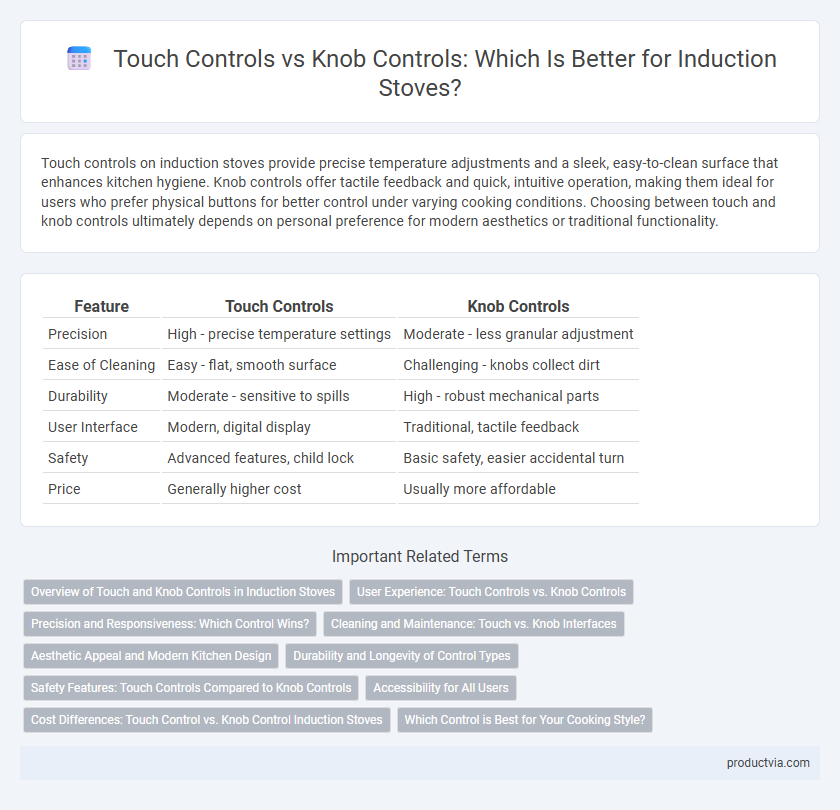Touch controls on induction stoves provide precise temperature adjustments and a sleek, easy-to-clean surface that enhances kitchen hygiene. Knob controls offer tactile feedback and quick, intuitive operation, making them ideal for users who prefer physical buttons for better control under varying cooking conditions. Choosing between touch and knob controls ultimately depends on personal preference for modern aesthetics or traditional functionality.
Table of Comparison
| Feature | Touch Controls | Knob Controls |
|---|---|---|
| Precision | High - precise temperature settings | Moderate - less granular adjustment |
| Ease of Cleaning | Easy - flat, smooth surface | Challenging - knobs collect dirt |
| Durability | Moderate - sensitive to spills | High - robust mechanical parts |
| User Interface | Modern, digital display | Traditional, tactile feedback |
| Safety | Advanced features, child lock | Basic safety, easier accidental turn |
| Price | Generally higher cost | Usually more affordable |
Overview of Touch and Knob Controls in Induction Stoves
Touch controls in induction stoves offer a sleek, modern interface with precise temperature settings and easy cleaning due to their flat surface. Knob controls provide tactile feedback and intuitive adjustments, favored for their durability and traditional feel. Both control types enhance user experience but differ in responsiveness, aesthetics, and maintenance requirements.
User Experience: Touch Controls vs. Knob Controls
Touch controls on induction stoves offer sleek, easy-to-clean surfaces with precise temperature adjustments, enhancing user convenience and modern kitchen aesthetics. Knob controls provide tactile feedback and intuitive operation, preferred by users seeking physical interaction and immediate control without navigating digital menus. Both control types affect user experience differently, with touch controls emphasizing minimalism and advanced features, while knobs prioritize familiarity and ease of use.
Precision and Responsiveness: Which Control Wins?
Touch controls on induction stoves offer superior precision with smooth, incremental adjustments to temperature settings, enabling fine-tuned cooking control. Knob controls provide tactile feedback and quicker responsiveness, allowing immediate changes by physically turning the dial, which some users find more intuitive. Overall, touch controls excel in accuracy while knob controls lead in responsiveness, making the choice dependent on user preference for precision or speed.
Cleaning and Maintenance: Touch vs. Knob Interfaces
Touch controls on induction stoves offer a smooth, flat surface that simplifies cleaning by eliminating crevices where dirt and grease can accumulate, making maintenance quicker and more hygienic. Knob controls, with their physical protrusions and gaps, tend to trap grime and require more detailed cleaning efforts, potentially harboring bacteria over time. Choosing touch interfaces can enhance kitchen cleanliness and reduce the time spent on upkeep, crucial for maintaining an efficient cooking environment.
Aesthetic Appeal and Modern Kitchen Design
Touch controls on induction stoves offer a sleek, minimalist aesthetic that complements modern kitchen designs by seamlessly blending into smooth glass surfaces. Knob controls, while providing tactile feedback and easier grip, typically introduce a more traditional look that may disrupt the streamlined appearance of contemporary kitchens. Choosing touch controls enhances the overall visual appeal and aligns with the trend toward high-tech, clean kitchen environments.
Durability and Longevity of Control Types
Touch controls on induction stoves offer a sleek design but are generally more susceptible to wear and damage from spills and scratches, potentially reducing their longevity compared to knob controls. Knob controls, made of durable plastic or metal, withstand frequent use and physical impact better, providing enhanced durability for long-term operation. Choosing knob controls often results in a more reliable and longer-lasting user interface for induction stove functionality.
Safety Features: Touch Controls Compared to Knob Controls
Touch controls on induction stoves enhance safety by minimizing physical contact points where dirt and spills accumulate, reducing the risk of electrical faults. These controls often include child lock features and automatic shut-off functions that prevent accidental activation or overheating. In contrast, knob controls may lack precise safety mechanisms and can be more prone to wear and unintentional adjustments during cooking.
Accessibility for All Users
Touch controls on induction stoves offer sleek, flat surfaces that are easier to clean and allow precise temperature adjustments, benefiting users with limited dexterity or mobility. Knob controls provide tactile feedback and physical resistance, which can aid visually impaired individuals and those who prefer tangible interaction. Ensuring induction stoves feature both control options or accessible designs enhances overall usability and inclusivity for diverse user needs.
Cost Differences: Touch Control vs. Knob Control Induction Stoves
Touch control induction stoves generally cost more due to advanced sensor technology and sleek design integration, with prices often starting 20-30% higher than knob control models. Knob control induction stoves offer a more affordable option, favored for their durability and straightforward operation, typically priced lower in entry-level ranges. The price difference reflects manufacturing complexity and user interface preferences, impacting overall budget considerations for buyers.
Which Control is Best for Your Cooking Style?
Touch controls on induction stoves offer precise temperature adjustments and easy cleaning, making them ideal for tech-savvy cooks who value sleek design and modern functionality. Knob controls provide tactile feedback and quick response, preferred by chefs who need rapid changes and robust handling during intense cooking sessions. Choosing the best control depends on whether you prioritize accuracy and aesthetics or durability and direct manipulation in your cooking style.
Touch controls vs Knob controls for induction stoves Infographic

 productvia.com
productvia.com